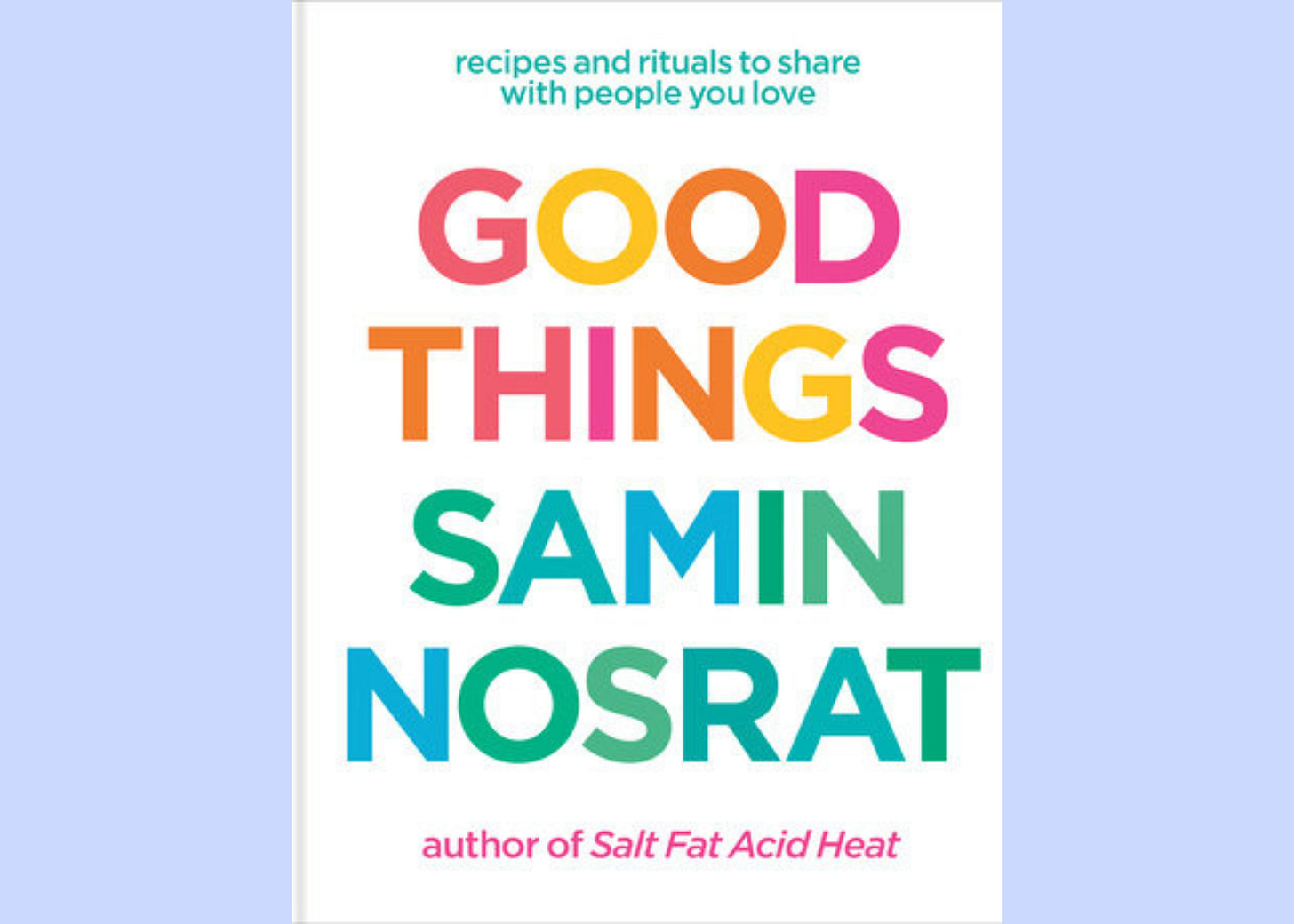Letting Go and Cooking On: Good Things
Good Things: Recipes and Rituals to Share with People You Love
For a woman who seemed to exude joy in her first book and public appearances, Samin Nosrat has produced a second book that pulls back the curtain a bit. There’s a lot of letting go of angst in Good Things—about achieving restaurant-worthy cooking at home, about relaxing and staying present when cooking for friends, and about establishing a weekly dinner with friends.
Without going into detail, Nosrat explains that she dealt with the deaths of several people close to her; pandemic isolation right after settling into a new home, coming off long years of work travel; and depression, all pointing her to a calmer existence focused on time with others. So she figured out what recipes and casual cooking guidelines qualified to her as “good things” worth putting into a cookbook.
In so doing, Nosrat has written a warm, colorful book that may give cooks, especially newer ones, the kitchen confidence she envisions for themselves and friends.
Good Things seems best suited for readers who are advanced beginners. Nosrat gives them a nice runway, from simple explanations of how to boil, roast, or sauté vegetables, to slightly more challenging pita, to full-on homemade lasagna noodles.
Experienced cooks will find fewer wholly unexpected recipes, but they will still find plenty of tips tucked in amid the familiar. One example stood out on a first skim of the book: It seems to have become a rule that every new book must include a cacio e pepe pasta, but Nosrat has picked up the method of whizzing up a cheese paste in a food processor to toss with noodles and some of their cooking water—a more foolproof method than the frantic stirring most recipes require.
The book is organized by chapters with uninformative names (“Good Things Come in Small Packages” turns out to be condiments and building blocks for other recipes; “Good Things to Keep Up Your Sleeve” is recipes from pantry staples). Given that, it’s frustrating not to have a list of recipes at the start of every chapter, a now-common format that would be especially appreciated in a book with chapters that can run to 50 pages.
Noting her distaste for traditional recipes, Nosrat flips between many full, standard-format recipes and shorter, paragraph-style ones. Both work; the more-casual paragraph format easily walks a cook through a recipe without breaking everything out into sometimes-stilted steps. (The Joy of Cooking owners will recognize the style.) It would have been better, though, to boldface not just the ingredient but the amount as well (6 garlic cloves, not 6 garlic cloves).
But there are multiple irritations in here. Maybe they trace back to her antipathy toward traditional recipes, but they felt sloppy at best and disrespectful of readers at worst:
Recipe writers usually try to signal to readers when an ingredient is used in multiple ways, either by listing its uses separately (putting butter amounts under both “batter” and “frosting”), or saying “4 tablespoons butter, divided.” Nosrat does neither, making it far too easy to miss the amount within the instructions and plop in all of an ingredient at once.
Her inconsistency in calling for an ingredient by weight is so consistent that it becomes almost comical—to wit, a recipe for whipped tahini that calls only for “½ cup tahini,” but “1 teaspoon (3g) kosher salt.”
Sometimes recipe instructions lack clarity or seem to require more steps than necessary. A chicken recipe calls for the bird to be salted in advance, pointing readers to another page, but that offers only the general concept, with few details (how much salt? Refrigerate? Uncovered or not? Wipe off the salt before cooking?). A spicy tuna pasta’s instructions for cooking the sauce get interrupted by instructions to add the pasta to the boiling water, cook for 7 to 12 minutes, reserve some cooking water, and drain the pasta. But there’s no “meanwhile” anywhere in that paragraph or the next one—and the next begins with adding a can of tomatoes to the sauce and ladling a little of the cooking water into the can to rinse it. So, are cooks supposed to just stand around for 7 to 12 minutes—while the interrupted sauce continues to cook?
And readers may wonder if the page designer had any cooking experience. Presumably not, or they would have understood how exceptionally annoying it is to have a headnote take up an entire page—alongside which runs the ingredient list, forcing cooks to continually turn back a page from the instructions to the ingredients. This happens mercifully less often than the other annoyances, at least.
Overcome those obstacles, though, and some delicious creations will emerge.
Take a morning to put together some of Nosrat’s simple building blocks; your future self will thank you. Prep that whipped tahini, fluffy and light, alongside some whipped ricotta, and spread on a serving platter for an excellent, quick base for roasted vegetables (the tahini was even better with not just the lemon juice called for, but the zest of the lemons as well).
Marinated feta cubes—bright with lemon (or kumquats if you’re lucky enough to have a supply), chile, bay, and peppercorns—perk up any simple green salad. Dark-roasted, roll-cut carrots became a full-flavored side dish when tossed in a creamy lemon-miso dressing thickened with aquafaba and flecked with poppyseeds. (That dressing led to questions about unnecessary steps; in a moment of recipe-testing distraction, all the ingredients went into the immersion blender cup, instead of Nosrat’s two-step process of mixing up an aquafaba “mayonnaise” first and then drizzling in a lemon juice-miso mixture. Maybe her longer method would have produced something even smoother or fluffier, but hey, it’s just dressing—and it was still one of the best of the tested recipes.)
Nosrat’s Roquefort dressing took advantage of an often-underused ingredient: water. To get the dressing—thick with cheese, sour cream and olive oil—to your desired runniness, simply add water. It’s easy to imagine many newer cooks trying to thin it with more oil or vinegar instead of this simplicity.
The tuna pasta, meant to be assembled from pantry staples, boosted a sauce of onion, garlic, and canned cherry tomatoes with the oomph of anchovies and Calabrian chile paste. Here, too, the instructions may frustrate a cook—it’s an early step in the saucemaking that calls for chile paste “to taste” with zero quantities suggested. How should a cook know at that point even where to begin? Parmesan, lemon, and canned tuna round out the flavor, though tasters wished for one more can of tuna to balance all the pasta.
A short chapter of basic breads includes focaccia, pita, and sesame flatbreads. Honey-oat dinner rolls kept moist with a cooked porridge of ground oats plus sour cream worked fine; take note of how dark the rolls are in the accompanying photos—necessary for fullest flavor.
In a chapter devoted to chicken recipes, a Dutch oven braise of a whole chicken over pearl couscous flavored with torn Medjool dates and preserved lemon paste proved a real standout. With garlic, onion, and a hefty dose of cumin as well, the dish took on layers of sweet-salty goodness. While not a weeknight meal given the long cooking time, this packed a bunch of punch for relatively little effort.
About that preserved lemon paste: It’s still a relatively uncommon ingredient, so making the paste may be one of the book’s best takeaways, pureeing preserved lemons (both peel and flesh) with optional turmeric for a sunny condiment that’s even easier to use than whole preserved lemons. It proved its worth in both the chicken and a lemon cake, where the paste combined with labneh to create a tangy, tender cake with complexity.
Despite some interesting recipes like that, the dessert chapter was the weakest overall (honestly, did you really need another banana bread recipe?). Also good, though, were tender-crisp cardamom shortbread rounds, despite looking at first glance far too heavy on the powdered sugar—until a reread of the weird yield revealed that it makes 120 cookies (“Makes 40 little cookies plus enough dough for 80 more”).
Quick takes:
Good Things: Recipes and Rituals to Share with People You Love, by Samin Nosrat. 464 pages. Published by Random House, 2025.
Organization: Chapters on building blocks, appetizers and drinks, salad dressings, pantry dishes, vegetables, dishes for dinners with friends, breads, and desserts.
Ingredients measurement methods: Comically inconsistent.
Photos: Most recipes have accompanying photos.
Index: Decent, could have been better; for example, Burnt Honey Hot Fudge, despite the recipe page being labeled as “sauces and preserves,” gets no index listing under “sauces.”
Disclosure: I am an affiliate of Bookshop.org, which supports independent booksellers, and I will earn a commission if you click through and make a purchase on the title above.
The Spice of Life
Everything is better with Pepper
Pepper thinks sharing your food is a lip-smacking good thing.
.





I’ve started reading it and, as more of an intermediate cook, am wondering whether it’s for me, but I should clarify the weight measure for salt: she states in her introduction chapter about ingredients that she gives kosher salt measurements in weight because the brand she uses, Diamond Crystal, is less dense than your standard Morton salt, so a teaspoon of Morton kosher salt contains a lot more salt than a tsp of Diamond Crystal. So instead, she goes by weight— 3 g of Morton is going to look different than 3 g of Diamond Crystal in a teaspoon measure, but if you go by weight, you’ll get the right amount. That being said, if she uses weight intermingled with cups & spoons for ingredients other than kosher salt, then that seems inconsistent— I haven’t cooked from it yet. Hope that helps. :) I’m going to read a few chapters like a novel and figure out whether the teaching in there is a reason to keep the book (I have a one-in/ one-out policy because of space constraints, so I can’t keep them all)— at this point, I think it is. She’s a great teacher and seems like a lovely person.